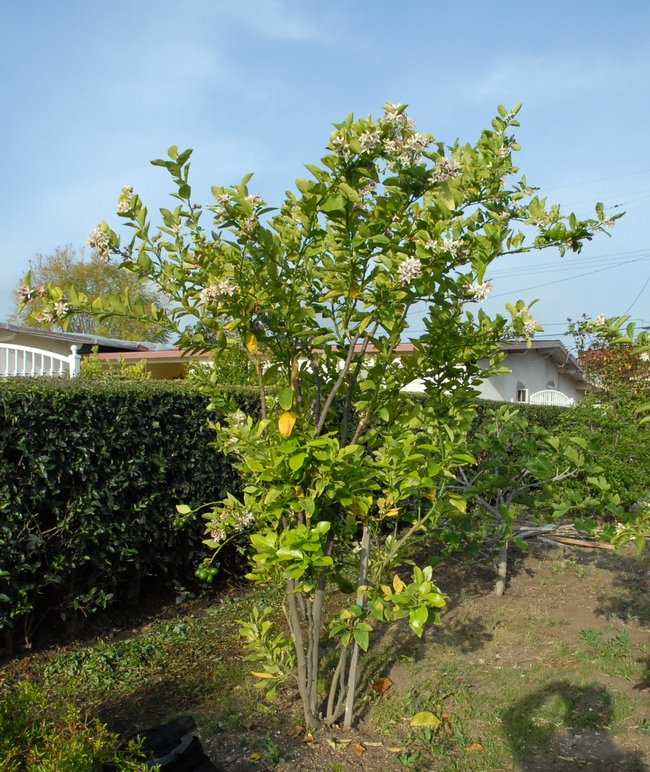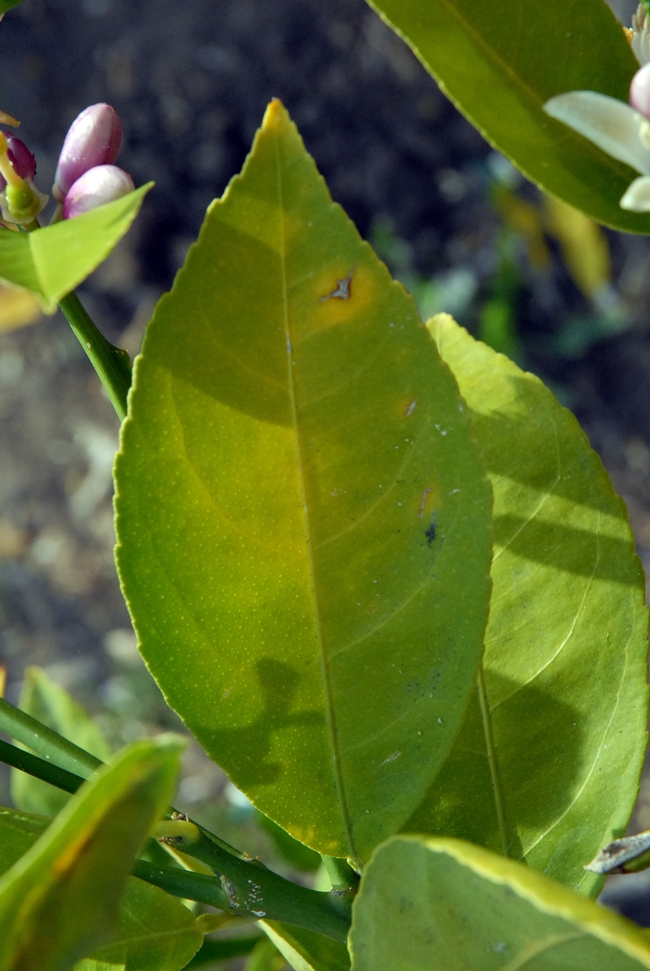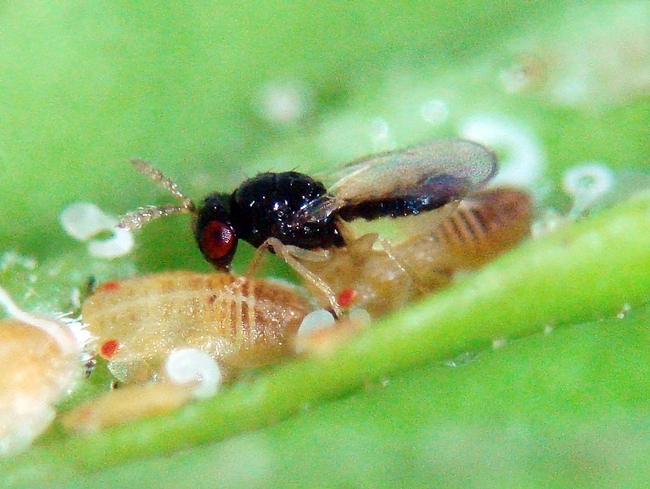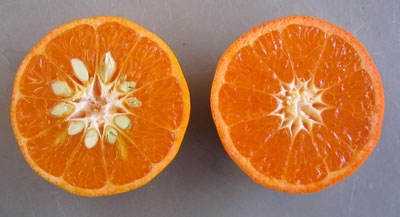Posts Tagged: Mikeal Roose
UC ANR scientists urge citrus farmers and backyard growers to be vigilant in face of new disease find
Now that two additional backyard citrus trees in Southern California were found to be infected with the bacterium that causes Huanglongbing (HLB) disease, UC Agriculture and Natural Resources (UC ANR) Cooperative Extension advisors and specialists are encouraging all citrus owners to monitor for disease symptoms and report trees suspected to be infected with HLB to the California Department of Food and Agriculture (CDFA) hotline, (800) 491-1899.
This month, a lime tree and a kumquat tree with HLB were identified in residential areas of the San Gabriel Valley. In March 2012, an infected multi-grafted citrus was found in a Hacienda Heights backyard.
“So far, the bacterium that causes HLB has been found infecting only three trees, which have all been destroyed,” said Beth Grafton-Cardwell, UC ANR Cooperative Extension citrus entomology specialist. “However, it is highly likely there are other infected trees in California. It will be critical for all Californians to assist with efforts to reduce psyllids and detect and remove infected trees to prevent this disease from devastating California citrus.”
An early symptom of Huanglongbing disease is yellowing of leaves on an individual limb or one sector of the tree's canopy, according to a UC ANR Integrated Pest Management Program Pest Note. Leaves that turn yellow from HLB will show an asymmetrical pattern of blotchy yellowing or mottling of the leaves. The Pest Note includes color pictures and detailed symptom descriptions.
HLB disease is spread from tree to tree by Asian citrus psyllid, an invasive insect first identified in California in 2008. ACP has become established in many Southern California communities and is seen occasionally in the state's San Joaquin Valley and Central Coast commercial citrus production areas. Locations where ACP are found are quarantined by CDFA. No untreated or unprocessed citrus fruit and no citrus trees may be moved from these areas. UC ANR maintains an online map that delineates the quarantined locations. The map also shows the area quarantined because of the recent HLB find.
Once a tree is infected with the bacterium that causes HLB, there is no cure. To prevent HLB infections, citrus owners in areas where Asian citrus psyllids are found may wish to treat their trees with insecticides.
“We believe about 60 percent of Californians have at least one citrus tree in their yard, so HLB could have a devastating effect on the California residential landscape,” Grafton-Cardwell said. “There are safe and effective ways to reduce the ACP population, which reduces the chances of losing a tree to HLB.”
Grafton-Cardwell developed a website for farmers and residents with detailed information on managing Asian citrus psyllid. In some urban areas, a natural enemy of ACP, Tamarixia radiata, has been released. In those areas, Grafton-Cardwell recommends the use of “soft” insecticides that will reduce the number of psyllids and allow the Tamarixia to control the rest.
If Tamarixia are not in the area, the website gives information on broad spectrum insecticides to reduce the number of psyllids. The website provides the names of the pesticides, their costs, the duration of control and the effectiveness of the pesticides against ACP.
To help California residents and commercial citrus growers deal with the ACP and HLB citrus threats, UC ANR, UC Davis and UC Riverside scientists are conducting research on a number of possible solutions.
For example, Abhaya Dandekar, professor in the Department of Plant Sciences at UC Davis, and his colleagues are studying gene fusion, which fuses two immunosuppressive genes that attack HLB in different ways to make the plant more effective at fighting the disease.
Mikeal Roose, a professor in the Department of Botany and Plant Sciences at UC Riverside, is working with researchers in Florida to sequence a rootstock that has some natural resistance to HLB and locate the gene or genes that cause HLB resistance.
Mark Hoddle, UC ANR Cooperative Extension biocontrol specialist at UC Riverside, has identified a second natural enemy of ACP from the Punjab, Pakistan. (The first one was Tamarixia radiata.) Populations of Diaphorencyrtus aligarhensis have also been released in urban areas and Hoddle is monitoring the insect's ability to attack ACP.
Because it is important to remove trees infected with HLB as soon as possible to reduce spread, UC scientists are also studying ways to identify trees with the disease before visual symptoms occur.
For example, Hailing Jin, professor in the Department of Plant Pathology at UC Riverside, has identified small RNAs that are induced by the bacterium that causes HLB and could be used for early diagnosis.
Carolyn Slupsky, professor in the Department of Food Science and Technology at UC Davis, has identified metabolites that change in concentration when citrus is infected with the bacterium that causes HLB. She is working with the Citrus Research Board (CRB), CDFA, Texas A&M, and USDA to validate her results and determine how quickly the disease may be detected once the tree has been exposed to the pathogen. She is also part of a USDA collaborative grant to study the vector that transmits the disease to help find ways to stop transmission.
Wenbo Ma, professor in the Department of Plant Pathology Microbiology at UC Riverside, has developed antibodies against proteins secreted by the HLB pathogen – revealing whether the plant is infected. These antibodies have been evaluated in California, Florida and Texas for HLB detection.
An initiative to manage endemic and invasive pests and diseases is part of UC Agriculture and Natural Resources Strategic Vision 2025.
This story is also available in Spanish.
Author: Jeannette Warnert
UC's Tango mandarin touted in Smithsonian
UC Riverside research that resulted in the new, seedless mandarin variety Tango was featured in a Smithsonian magazine article written by Sarah C. Rich.
The story recounts how plant geneticist Mikeal Roose used irradiation on W. Murcott budwood to induce mutations that improve the fruit.
“Farmers have long selected citrus varieties that are low-seed, that have the same kinds of chromosomal rearrangements stimulated by the same thing—there’s natural radiation around all the time and it can affect the trees at any time.”
The advantage of inducing mutations, Roose explained, rather than waiting for the sun to trigger genetic variation, is that it can be targeted toward manipulating one particular feature—a kind of rapid prototyping for agriculture. The radiation accelerates the output of new genetic compositions. Each is then cultivated, screened and tested with the hope that at least one offspring will be reliably superior to its antecedent.
'Doom the Broom' demo is scheduled Thursday in Paradise
Chico Enterprise-Record
A live fire demonstration will help illustrate the need to clear growth from around structures and to be aware of the growth of Scotch, Spanish and French broom Thursday in the parking lot at 5400 Clark Road, Paradise, Calif. Glenn Nader, UC Cooperative Extension advisor for Sutter-Yuba counties, an expert in livestock and natural resources, will talk about spraying herbicides to control the weeds.
The event will go from 10:30-11:45 a.m., rain or shine. The fire demonstration will be at 11:05 a.m.
Tango to be a big hit
A new, virtually seed-free mandarin will for the first time be sold in California grocery stores, but consumers may not even notice, according to an AP story by Jeff Nachtigal published late last week. Google News reports that the article made its way into about 200 news outlets.
The story was also written up by reporter Mark Muckenfuss of the Riverside Press-Enterprise in mid-January.
UC Riverside began releasing budwood for Tango mandarins in 2006; more than a million trees are now growing in California. Their first commercial crop is being harvested this month.
Tango is the result of a mutation induced by irradiating budwood of W. Murcott mandarin in UC Riverside genetics professor Mikeal Roose's lab. It has all the good qualities of W. Murcott, but doesn't produce seeds even if bees visit the blossoms covered in pollen from other citrus trees.
Roose told Nachtigal the new mandarin is "like a new car with all the details of the previous year's model, but one that gets 10 miles more to the gallon."
"It's probably the best piece of fruit that's come along for years for citrus growers," Roose was quoted.
Roose said Tango will most likely be marketed as Cuties and Delites. Some may be sold under the Tango name at grocery stores and farmers markets.
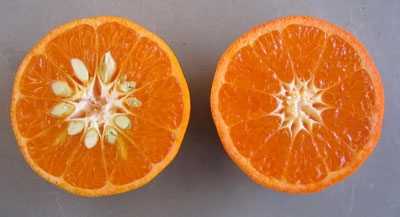
W. Murcott mandarin (left) and Tango (right).
Tango mandarins are soon to appear in a produce aisle near you
The first commercial crop of an exceptional new mandarin variety created by UC Riverside scientists will be harvested this month.
The fruit, called Tango, is the result of a mutation induced by irradiating budwood of W. Murcott mandarin. The process mimics nature’s manner of improving fruit. Radiation from the sun or natural errors during cell division can cause a single branch or fruit to mutate and develop unique characteristics, which scientists call a “sport.” People have been reproducing favorable sports for generations. In fact, all navel oranges are sports – natural mutations of oranges with seeds or other navel oranges.
W. Murcott mandarins, originally from Morocco, are favored for their deep orange color, easy-peel rind and tangy-sweet flavor. However, when planted within five miles of other seed-bearing citrus – such as Clementine mandarins, lemons or grapefruit – they can be cross-pollinated by bees and become seedy. The Tango maintains the best W. Murcott traits, but because it produces very little viable pollen, it is virtually seedless wherever it is grown.
“This is the most promising mandarin the university has ever produced,” said UC Riverside genetics professor Mikeal Roose.
The Tango mandarin was patented, and registered trees were established by the UC Citrus Clonal Protection Program. Distribution of budwood to citrus nurseries began in June 2006 and was limited exclusively to California growers for one year. Tango was introduced into Florida in 2007 and the trees were available internationally under exclusive licenses in 2009. Tango trees should soon be available to home gardeners through retail nurseries.
In all, 1.6 million Tango trees were sold in California through March 2010.
Tango is not a trademarked name, so the new seedless mandarin will probably be sold under existing grower brand names like Cuties and Delites. Before Christmas, fruit marketed as Cuties and Delites are early ripening Clementine mandarins. Most W. Murcotts and now Tangos will be sold as Cuties and Delites when they ripen in late January, but some Tangos will show up in supermarkets and farmer’s markets under the Tango name.
The Tango was made possible by a UC and citrus industry partnership going back nearly 15 years. Roose and staff research associate Tim Williams began field testing the fruit in 2001. The research and evaluation program was supported by the Citrus Research Board.
“What’s exciting is the parent variety of the Tango is a good piece of fruit,” said Ted Batkin, director of the Citrus Research Board. “It is without a doubt the most widely planted variety that we have released in the past 25 years.”

W. Murcott mandarin (left) and Tango (right).

